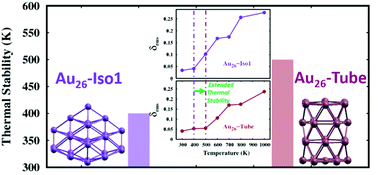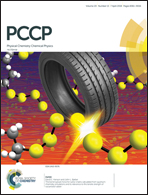Au26: a case of fluxionality/co-existence†
Abstract
The Au26 cluster is one of the widely studied gold clusters in the size range of n = 21–30. It has been proposed in a more recent combined experimental and theoretical study that the neutral Au26 cluster is fluxional. The fluxionality of a cluster is relevant to its catalytic applications. In this context, to explore the extent of fluxionality, Born Oppenheimer Molecular Dynamical (BOMD) simulations are carried out on experimentally and theoretically proposed fluxional Au26 conformations (three compact or core–shell structures and a high symmetry cage structure). The simulations reveal that the high energy golden tube outperforms the ground state structure (compact C2v conformation) as well as the other two low-symmetry compact conformations in terms of thermal stability. The enhancement in the thermal stability is explained on the basis of structural integrity imposed by the open skeleton of shortest bond distances within Au26-Tube. In addition to this, the homogeneous distribution of charges and the strong s–d hybridization exhibited by FMOs are seen to play a pivotal role in increasing the stability of Au26-Tube. The present investigation also reveals that the characteristic fluxionality proposed to exist in the Au26 system is noted only above 400 K and it is missing at room temperature. The simulations also bring forth the question of how relevant a ground state conformation is at working temperatures.



 Please wait while we load your content...
Please wait while we load your content...